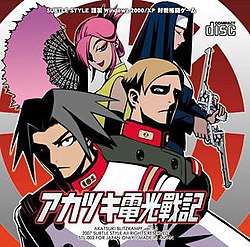Akatsuki Blitzkampf
| Akatsuki Blitzkampf | |
|---|---|

Box art of the game
|
|
| Developer(s) | Subtle Style |
| Publisher(s) | Subtle Style |
| Platform(s) | Microsoft Windows |
| Release | April 30, 2007 |
| Genre(s) | 2D fighting game |
| Mode(s) | Single-player, multiplayer |
| Akatsuki Blitzkampf Ausf. Achse | |
|---|---|
|
Promotional art of the game
|
|
| Developer(s) | Subtle Style |
| Publisher(s) | PIC |
| Platform(s) | Arcade (Sega NAOMI) |
| Release | February 20, 2008 |
| Genre(s) | 2D fighting game |
| Mode(s) | Single-player, multiplayer |
Akatsuki Blitzkampf (アカツキ電光戦記 Akatsuki Denkō Senki?) is a Japanese dōjin 2D fighting game, developed by the dōjin circle SUBTLE STYLE for Microsoft Windows. Released on April 30, 2007, the game is a sequel to Akatsuki Shisei Ichigō. The title got a lot of attention in Japan and elsewhere for its high-resolution sprites and older style gameplay.
On September 27, 2007, Arcadia Magazine confirmed that the game would be launched as an arcade title, published by SUBTLE STYLE itself. The Arcade game was called Akatsuki Blitzkampf Ausf Achse and it was released on February 20, 2008 for the Sega NAOMI system.
Akatsuki Blitzkampf (or Denkō Senki in Japanese) is set in a fictional future involving several characters that roughly resemble the German soldiers of the World War II era, among others. In-game visuals supplement this sort of specific militaristic theme and environment, portrayed by the flat and somewhat cubist character portraits and story sequence images. Blitzkampf is also a follow-up to a previous SUBTLE STYLE release from 2003 called Akatsuki Shisei Ichigō, involving many of the characters from the previous game.
In terms of Blitzkampf's play style, it is regarded as relatively "old school" in comparison to many other dōjin fighter releases such as Melty Blood, Eternal Fighter Zero, or Big Bang Beat, as many of the systems and conventions in the game are rather similar to several late 90's fighting games created by Capcom. For example, many players allude to the parry system, which resembles the one from the Street Fighter III installments. The gratuitous amount of extra modes the game provides (such as Survival, Time Attack, or SUGOROKU) and the ways that they are unlocked is largely reminiscent of a console release of an arcade fighting game, further reinforcing the semi-retro feel. In other words, the game focus is upon space control and careful footwork instead of flashy combos and intense aerial combat.
...
Wikipedia
